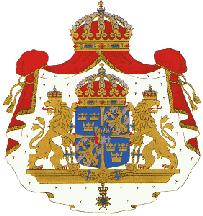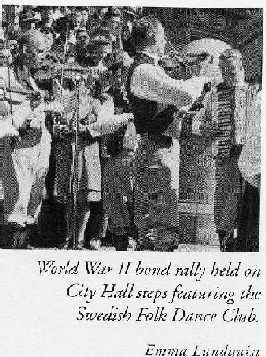A Villager, A Swede
Take a stroll down Millbury, Stebbins or Whipple street today, and you would never imagine what Quinsigamond had been like just over fifty years ago. Its citizens' diverse ethnic backgrounds create a palate of multiculturalism that would have flabbergasted the residents of old. People of all colors walk the villages' streets, and it is common to hear a smattering of Spanish spoken here and there. But the village's street names still speak to a powerful past: Stockholm, Malmo and Halmstad proclaim the village's once inviolable Swedish identity to generations to come.
 Herbert
Berg, a proud Quinsigamond resident and the village's unofficial historian,
claims that by 1900, 2,200 Swedes lived in Quinsigamond village out of
a total population of 2,786 (1).
Current residents claim that the proportion may have been as high as 90
percent by the Second World War (Rudge
and Schelin).
The emigration of Swedes to Worcester, and eventually Quinsigamond, was
part of a larger immigration trend that swept through Sweden from the
mid to late 1800's. Its economy was industrializing and the agricultural
sector shrinking due to improved farming techniques which increased worker
productivity. The economic change created a labor surplus and Swedes turned
their eyes to the United States for work opportunities (2).
In specific, the Swedes who came to Quinsigamond found employment in Washburn
and Moen's South Works (later American Steel and Wire), where they would
become skilled wire manufacturers and gain a reputation for their strong
work ethic. Settling into their work lives in the New World, the village
Swedes would cultivate a unique village identity starting in the 1870's
(3).
Herbert
Berg, a proud Quinsigamond resident and the village's unofficial historian,
claims that by 1900, 2,200 Swedes lived in Quinsigamond village out of
a total population of 2,786 (1).
Current residents claim that the proportion may have been as high as 90
percent by the Second World War (Rudge
and Schelin).
The emigration of Swedes to Worcester, and eventually Quinsigamond, was
part of a larger immigration trend that swept through Sweden from the
mid to late 1800's. Its economy was industrializing and the agricultural
sector shrinking due to improved farming techniques which increased worker
productivity. The economic change created a labor surplus and Swedes turned
their eyes to the United States for work opportunities (2).
In specific, the Swedes who came to Quinsigamond found employment in Washburn
and Moen's South Works (later American Steel and Wire), where they would
become skilled wire manufacturers and gain a reputation for their strong
work ethic. Settling into their work lives in the New World, the village
Swedes would cultivate a unique village identity starting in the 1870's
(3).
The identity was fostered by a close-knit community of churches, businesses, and civic organizations that thrived up through World War II. The churches played perhaps the strongest role in defining what it meant to be a Swede in Quinsigamond. Aside from the Lutherans, most Quinsigamond residents belonged to Swedish "dissenter" churches, such as the Methodist, Congregationalist, and Baptist churches (4). As a whole, they placed a high priority on moral behavior and became firm supporters of temperance and prohibition. We will see later that they also served as a focal point of village social activity. In addition to joining the churches, villagers participated in organizations such as the Scandanavian Vasa Order of America or the temperance-minded local International Order of Good Templars, while Swedish American businesses gave the community a distinct sense of self-sufficiency (5). One time resident Edward Hult recalls the no longer existent storefronts that peppered Millbury Street before and during World War II:
…I said there were two drug stores, and there was a First National Store […] then there were a couple of barber shops down there […] and further down we had a jewelry store […] and then of course there were some more grocery stores down there […] and then there was a five and ten down there and there was the bakery, and another bakery further down. I mean, Quinsig was really compact, and anything you wanted, you could buy it here….
Wesley Holm attests to the Swedish ownership of these businesses stating that during the war era, "…you know, the community was Swedish. The grocery stores were Swedish, the other stores were Swedish [too]."
If there was a turning point, however, for the importance of Swedish
identity to villagers, it quite possibly arose with the World War II generation's
coming of age. When questioned on the significance of Sweden's neutrality
to villagers during World War II, Swedish-born resident Olaf
Rydstrom remarks, "It didn't bother me at all. I had nothing
to do with it. I was over here […] I always thought of myself as
American." Ed
Steele concurs, "…I think when the war was on we were Americans.
I really think that, at least that's the way I felt." The new generation
had been born and raised in Quinsigamond, and like second and third generation
ethnics across America, they increasingly identified themselves with different
nationalities and backgrounds. It was as important to be American, as
to be Swedish.
 After
the war, it became clear that one of the war's legacies would be Quinsigamond's
loss of its Swedish American identity. Gordon
Forsberg recalls that there was a migration of original tenants out
of the community following the war: "The minute the war was over
[…] it started- everybody, everything changed then-it had to. Everyone
was coming home from the service, and some guys they moved away."
He continues, "I mean, some people moved to Holden. It depends on
where your girlfriend's from in many instances, you know what I mean,
you marry a girl from Holden, you move out there…". Quinsigamond's
small geographic size and modest triple-decker houses, other residents
agree, were too confining for raisng new families. Edward
Hult remarks, "…like in my family, there were three children,
we all moved away. This happened to many families […] Quinsigamond
village, it didn't have the growth." In moving out of Quinsig, Mr.
Hult would be one of thousands of post-war families nationwide that
would migrate to the suburbs. As the Quinsigamond villagers moved out,
a new population- including a new generation of immigrants- took their
places.
After
the war, it became clear that one of the war's legacies would be Quinsigamond's
loss of its Swedish American identity. Gordon
Forsberg recalls that there was a migration of original tenants out
of the community following the war: "The minute the war was over
[…] it started- everybody, everything changed then-it had to. Everyone
was coming home from the service, and some guys they moved away."
He continues, "I mean, some people moved to Holden. It depends on
where your girlfriend's from in many instances, you know what I mean,
you marry a girl from Holden, you move out there…". Quinsigamond's
small geographic size and modest triple-decker houses, other residents
agree, were too confining for raisng new families. Edward
Hult remarks, "…like in my family, there were three children,
we all moved away. This happened to many families […] Quinsigamond
village, it didn't have the growth." In moving out of Quinsig, Mr.
Hult would be one of thousands of post-war families nationwide that
would migrate to the suburbs. As the Quinsigamond villagers moved out,
a new population- including a new generation of immigrants- took their
places.